
These two waves oscillate on different planes.
Key Terms
liquid crystals
polarized light
polarized sunglasses
Introduction
Most students have watches and calculators that display data using liquid crystals. You may even be reading this from a computer monitor with a liquid crystal display. Liquid crystal technology is easily understood if you understand the concept of polarized light ... so that is where we will start.
Ordinary white light is made up of many kinds of waves of different wavelengths (you already know that). But what we haven't discussed is the orientation (alignment in space) of the waves. In most cases, it is totally random. To help illustrate the point, consider the alignment of the two waves below. One "wiggles" up and down and the other "wiggles" left and right. In fact, it can "wiggle" on any plane in between ... giving an infinite number of possibilities.

These two waves oscillate on different planes.
Polarized light is light where all the waves vibrate in the same plane. The filter itself consists of very long molecules that are aligned in one physical direction (much like vertical steel bars found in a jail cell). As an analogy, imagine trying to pass batons through the bars of a jail cell. Only batons oriented in the vertical direction could be passed through the bars. Horizontally oriented batons cannot pass through.
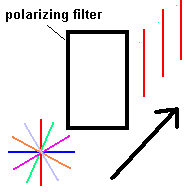
What happens if you place two polarizing filters together,... with the same physical (molecular) orientation? Nothing changes ... the light that passes the first filter has no problem passing through the second filter.
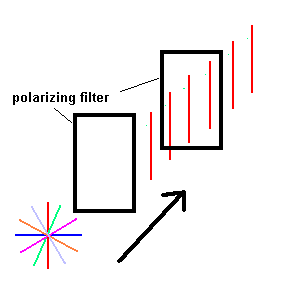
But what happens if we rotate the second filter 90 degrees with respect to the first filter and shine light through? Now nothing can pass, and there is only darkness on the other side.
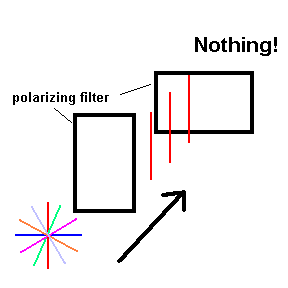
Click link 5.6.a to see a Java applet that shows how light intensity changes as you vary the physical orientation of one filter with respect to the other. Notice that nothing gets through the system if one filter is oriented 90 degrees to the second. Also notice that the system becomes totally transparent if both filters have identical orientations and partially transparent when the angle of orientation is between 0-90 degrees. In fact, the second filter acts to progressively reduce the intensity of the overall transmitted wave as the orientation angle approaches 90 degrees.
Why is the intensity reduced if the two filters are tilted slightly with respect to each other?
|
|
Observe what happens as polarized light enters the second filter (animation) |
Think of the polarized light that enters the second filter (vertical red line) as having two components, one that is aligned with the filter molecules (along the length and shown in blue) and another that is perpendicular to the molecules (along the width and shown in green). One component (blue) gets through the second filter, but the other component (green) is blocked. The overall effect of the second filter is to reduce the intensity of the transmitted beam as the orientation angle increases to 90 degrees. In addition, the second filter has the effect of "twisting" the orientation of the incoming polarized light.
It should be clear why nothing gets through the second filter if the angle of orientation is 90 degrees with respect to the first polarizing filter.
Certain crystals transmit polarized light through them in a very unusual way. As the light moves through the crystal, it "twists" the plane of oscillation!

One way to accomplish this is by effectively placing many polarizing filters back-to-back, each one orientated at a slightly different angle with respect to the other. In this way, each filter "twists" the light slightly, and if the angle offset is not too great, the intensity does not suffer much reduction.
Scientists have found a way to do this using a "liquid crystal". These substances consist of a gel of long thin molecules (like thin spaghetti). These molecules are confined by two parallel sheets of glass and are able to move freely about (like a liquid), but tend to align themselves with adjacent molecules within the gel (like a crystal). Each molecule acts like a tiny polarizing filter, so if they were to all line up like spaghetti in a box, they will let all the light pass by. To make them twist like a helix, each glass plate is etched with lines that the molecules tend to align with. One glass plate has horizontal etches and the other has vertical etches. The molecules in between naturally form a helix (like the orientation of the blue lines in the image above). These crystals then become natural light "twisters" in terms of polarization.

Liquid crystals react to an external electric field (animation).
However, you can easily "untwist" this helix by applying an external electric field (as demonstrated in the animation above). If required, you can even change the intensity of the effect by varying the strength of the electric field.
So what happens if we place this liquid crystal between two polarizing filters that are oriented 90 degrees to each other? Light does go through!!!
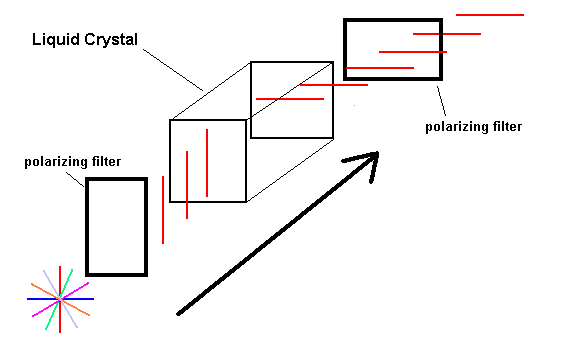
However, if a small voltage is set up across the crystal, it loses its ability to "twist" the orientation of a light beam. That is, it behaves as if it wasn't there at all. Can you predict what will happen to the light beam (in the diagram above) if we remove the crystal? You should see that nothing will get through, and this is the secret to liquid crystals. Depending on whether a voltage is applied or not, this system will either become opaque (dark) or transparent. It then becomes easy to display something on the screen because the screen is filled with tiny sections of liquid crystals. For example you can see how the numbers on a calculator can be made from only 7 different crystals.
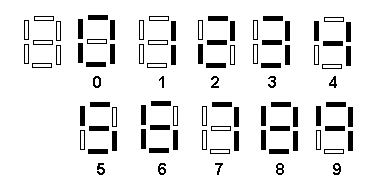
Ambient light can be used to create contrast by placing a mirror behind the entire setup. However, a background light source will have the advantage that it can be seen in the dark.
The same technology is used on "flat LCD screen" computer monitors and TV's. A fluorescent light lies behind the screen, but the type of light that gets to you depends on the condition of the liquid crystals in between. The entire screen is filled with minute individual light sources which form pixels. Each pixel actually consists of 3 separate liquid crystals, designed to transmit red, green, or blue light of different intensities. If you want to display blue, you open the blue filter (make it transparent), but close the red and green filters (make them opaque). If you want to see white, open all the LCD filters (make them all transparent). By changing the level of transparency, you can make any color appear. Click link 5.6.b to use a program that lets you mix RGB colors and change intensities to make other colors displayed on an LCD screen.
If interested, click link 5.6.c if you care to learn more about liquid crystal displays.
Reflections off water tend to become polarized.
Most people who fish know that polarized sunglasses are standard equipment. That is because the reflected glare from water, asphalt, and most non-metallic surfaces becomes polarized. Take a pair of polarized sunglasses outside and twist your head 90 degrees to observe the dramatic difference. While you are at it, do the same on any clear day. You should see that parts of the blue sky produce strongly polarized light.
Suppose you need to know if an object is in the correct position (for example, in an assembly line). Metal surfaces have the property that reflected light maintains its state of polarization, and non-metallic surfaces tend to alter the angle of polarization. That is, if the incoming light is already polarized, metals and nonmetals reflect the light differently in terms of polarity. The animation below shows what happens when a metallic surface is replaced with a non-metallic surface. Anything non-metallic that interrupts the beam can trigger a response.

Metallic vs. Non-Metallic Surfaces (animation)
©2001, 2004, 2007, 2009, 2016 by Jim Mihal - All rights reserved
No portion may be distributed without the expressed written permission of the author